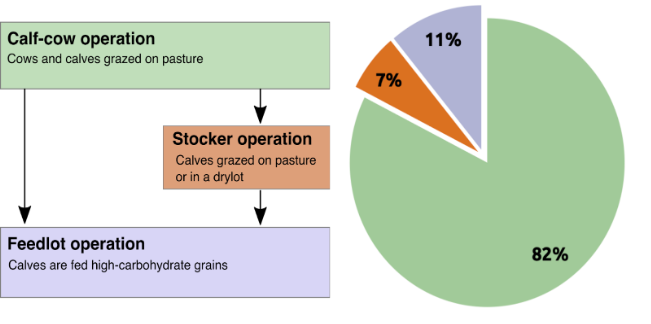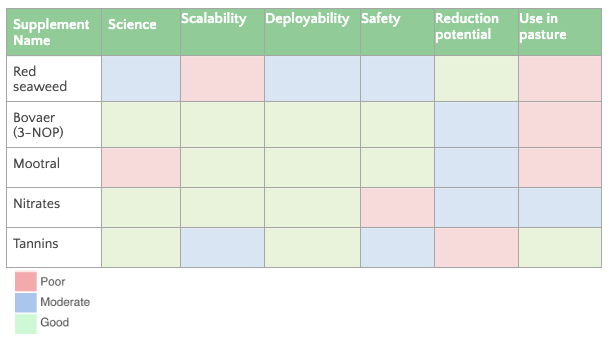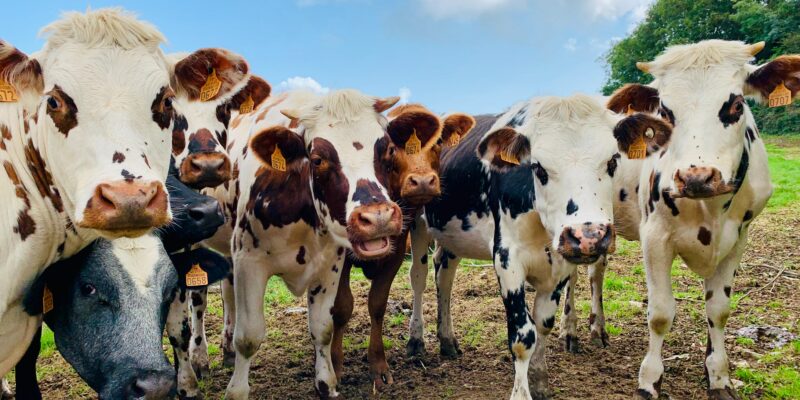Key points:
- Various natural and synthetic supplements for reducing methane emissions from cattle, sheep and goats are being developed, each with its own set of positive and negative characteristics
- Most supplements have only been tested in feedlots. Effectively administering them to animals on pasture, where cattle, sheep and goats spend most of their time and where most methane is produced, could prove challenging
- The methane offset potential varies considerably among studies of the same supplement, highlighting the fact that impacts are difficult to predict
- The lifecycle emissions of many supplements are poorly understood, and so a full understanding of their mitigation potential is lacking
- Scaling-up the production of some of these supplements in the near-term comes with its own set of challenges.
Methane from ruminant (animals with four-chambered stomachs, including cows, sheep and goats) burps is the single largest human-caused methane source across all sectors, contributing 25%–30% of global methane emissions. Due to urbanisation, a growing human population and an expanding middle class, global demand for milk and meat is expected to increase by 58% and 74% respectively by 2050 compared to 2010. To combat this rise, several measures for curbing methane from burps are being developed.
One of these measures involves feeding ruminants supplements that inhibit methane production in the stomach. Cows eat carbon contained in plants, and this carbon is converted into methane in the stomach by microbes before being burped out. These supplements work either by physically disrupting methane production, or by shifting the composition of the microbial community away from methane-producing microbes.
Though some supplements have shown promise for reducing methane emissions and are already being sold as voluntary carbon credits, questions remain about the scientific credibility, practicality, scalability, safety and efficacy of these products.
Natural supplements
Red seaweed (Asparagopsis) has received a lot of media focus in recent years on the back of trials reporting methane emission reductions of up to 98% (when as little as 0.2% of the diet is supplemented with dried seaweed powder). It is estimated that if just 20% of the beef and dairy market in developed countries incorporated the supplement into feed, up to 15% of global methane emissions from burps could be avoided.
The main active ingredient in the seaweed is a compound called bromoform, which is a methane-production inhibitor and probable human carcinogen – although concerning levels of bromoform have not been detected in the tissue or milk of cows fed red seaweed. These seaweeds are also rich in iodine, excessive amounts of which can cause thyroid dysfunction in humans. Concerns have also been raised about the ozone-depleting properties of bromoform. Levels of the inhibitor vary naturally due to the environment and genetics, which could translate into variation in the efficacy of the product.
Probably the biggest barrier to rolling-out this seaweed supplement in the near term is producing enough of it. Harvesting wild populations alone would be unsustainable, so aquaculture techniques would need to be developed, along with land for growing and drying facilities. Ideally, these facilities would be located near farms to avoid transport and other processing emissions, although growing seaweed does have potential environmental benefits, such as CO2 sequestration, water quality improvement and ocean acidification reduction. The development of these aquaculture facilities could support regional economies by using local labour for seaweed growing and processing.
More modest methane reductions of up to 30% have been achieved using garlic and citrus extract supplements, marketed under the name Mootral. However, this is only based on a few animal trials. In one trial, statistically significant results were only seen after 12 weeks, although the authors attribute this to the refusal of the animals to eat the feed at the start of the experiment. However, no safety concerns have been raised with the use of this product.
The methane offsets from Mootral are being sold as voluntary carbon credits, called CowCredits, which are issued by Verra. With no lifecycle assessment available, and only a small handful of animal trials published in peer-reviewed scientific journals, it is difficult to properly evaluate the offset potential or efficacy of this product.
Methane reductions of up to 30% have also been found when adding nitrate-rich foods into the feed, as this modifies the microbial community. Nitrate has obtained better results in dairy cows than in beef cows, with a lifecycle assessment of the potential net greenhouse gas reductions in the US dairy industry estimating a 5% reduction in CO2 equivalents. However, a major barrier to nitrate supplements is toxicity from nitrite – a by-product of nitrate metabolism in the stomach.
Synthetic supplements
One supplement that has received regulatory approval in Brazil, Chile and, soon, the EU, and for which there is substantial scientific evidence from animal trials, is 3-nitrooxypropanol, or 3-NOP. It is marketed under Bovaer (a combination of ‘bovine’ and ‘air’). The methane reduction potential averages 30% and lifecycle assessments report 11.7%–14% decreases in whole-farm dairy net greenhouse gas emission intensity when 3-NOP is used. 3-NOP also shows more promising results in dairy cattle than in beef cattle, with the same dose reducing methane emissions more in dairy cows than in beef cows.
The safety risks of 3-NOP to animals and humans are low. However, the compound degrades rapidly in the animal stomach so it needs to be supplied constantly, for example by incorporating it into feed, in order to work. ThMethane production across the different operations of the beef production systemis may be impractical for animals raised outside the feedlot (a yard or building where animals are fed in intensive production systems).
Typical lifecycle of beef cows in pastures and feedlots in the US
To understand how applicable these supplements may be in highly-developed, intensive beef-production systems, we can use the US as an example. The US is the largest beef-producing nation in the world (12.3 million tonnes in 2019), and the production system has a high proportion of cattle finished in feedlots – though Australia and South America are catching up.
In the beef production system in the US, a permanent herd of cattle is kept in order to produce calves (called the calf-cow operation). These cattle typically graze on inexpensive pastures such as grass. Of the calves born to this herd, about 60% will be raised on pasture for anywhere between 10 and 23 months (called the stocker operation) after which they will be finished in the feedlot (called the feedlot operation) for a further 100 to 300 days. The other 40% of calves go directly into feedlots for 240 to 280 days before going to slaughter. It is estimated that the permanent herd is responsible for up to 82% of the methane produced in the beef production system.
Methane production across the different operations of the beef production system

The feedlot issue
One obstacle shared by all the above supplements is that they have only been tested in feedlots. While they could, in theory, be given to cows raised on pasture, the practicality of doing so is likely to prove challenging, as feed is not as carefully controlled in pasture systems as it is in feedlots. Moreover, although some may consider cows raised on pasture to be more sustainable because they are eating fibrous plants that humans and other livestock otherwise cannot eat, pasture-raised cows actually burp more methane than cows that are fattened on more easily-digestible and nutrient-dense grains in feedlots. As most of the world’s cows spend the majority of their life on pasture and generally burp more methane than feedlot cows, an effective feed supplement must be effectively applicable to pasture-raised cattle.
Reducing emissions in pasture-raised animals
For pasture-raised animals, switching to more easily digestible legume forages could help reduce methane emissions. Tannin-rich forages or additives are another natural supplement option that can also be readily used in pasture systems. However, they have more modest reduction potential compared with some of the supplements mentioned above, with results varying greatly depending on the type of tannin. Tannins may negatively impact nutrient and protein digestibility and stomach health, affecting the animal’s ability to convert feed into milk and meat. It has been suggested that 3-NOP (Bovaer) could be supplied in lick-blocks or slow-release stomach devices for cattle on pasture, but the practicality of this has not been assessed. The effectiveness of 3-NOP was also found to decrease when higher amounts of fibre are eaten, implying that even if it were made available to cows on pasture, it may not be effective when low-quality forage is being eaten.
Environmental considerations
Though grain-fed feedlot cows produce less methane than grass-fed pasture cows, supplying these grains also comes with its own environmental impact. Feedlots are also significant sources of hydrogen sulphide (a toxic air pollutant) and major polluters of waterways with ammonia, pathogens and antibiotics. Concerns around increased antibiotic resistance are also growing. However, pasture systems come with their own set of concerns. For instance, if cattle production in the US were to shift from feedlot-based to pasture-based, herd size would need to increase by 30% to maintain present-day numbers because cows would take longer to fatten up and there would be less meat per cow. This shift would also result in greater methane emissions and other environmental costs, such as soil erosion, loss of native vegetation and water eutrophication (when water becomes overly enriched with nutrients, depleting oxygen levels).
Below is a table summarising the attributes of the supplements discussed, including the science (the number of studies and quality of the studies), scalability (how easily could this technology be scaled up for use in the near future), deployability (how readily could the technology be deployed), safety (potential safety concerns to humans, livestock and the environment), reduction potential (the extent to which methane could be reduced) and pasture use (the potential for the supplement to be used in pasture-based systems).
Summary of the supplements

In summary, many of these supplements are only in pilot phases or need more rigorous scientific research, especially animal trials, to fully understand their potential. There are major discrepancies in the methane reduction potentials reported among studies testing the same supplement, suggesting complex interactions of multiple variables, with impacts that are difficult to predict. Perhaps the biggest limitation of most of these supplements is that they have only been tested in feedlots. Controlling and monitoring the consumption of these supplements by cows in pasture systems, which produce the majority of global methane emissions from cattle, could prove particularly challenging, especially considering the palatability of many of them is low.
Read the original article via Zero Carbon Analytics


